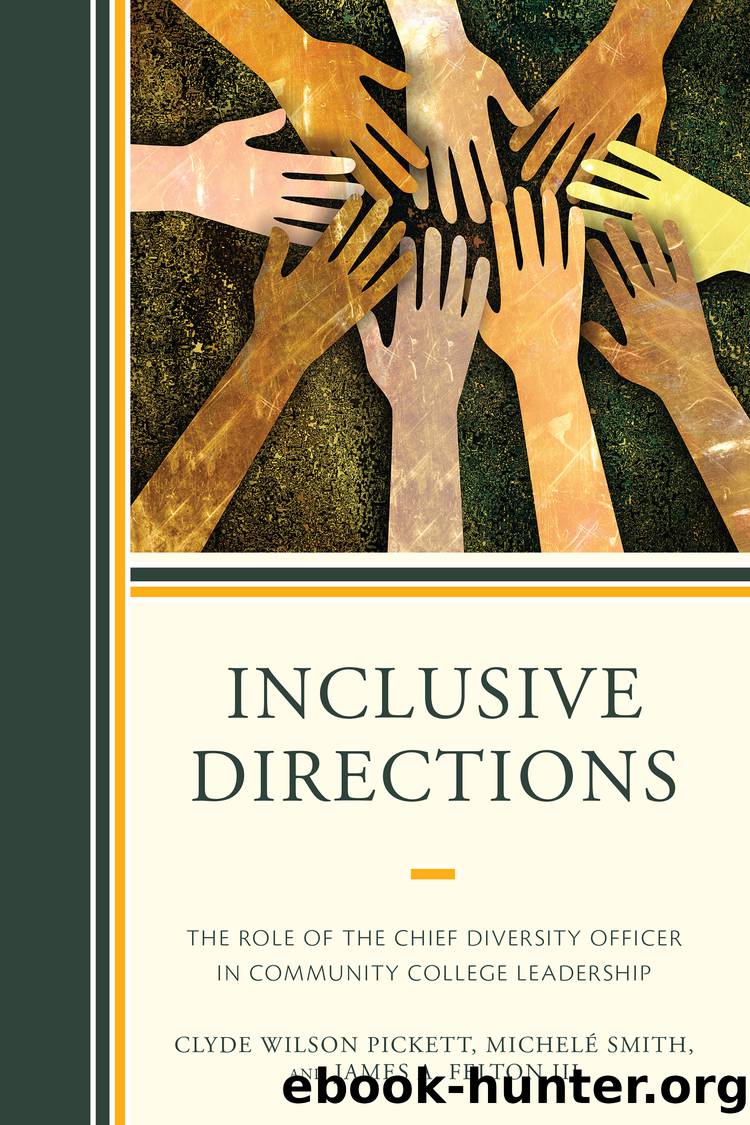Inclusive Directions by unknow

Author:unknow
Language: eng
Format: epub
Publisher: Rowman & Littlefield Publishers
Published: 2017-05-04T00:00:00+00:00
6
Chief Diversity Officer as Compliance Officer
As the role the chief diversity officer at the community college continues to expand, it is important to examine some of the most essential aspects of the position and how the responsibilities associated with these roles are closely related to other essential functions at institutions of higher education. A quintessential function at any institution is the position of the primary compliance officer, who is charged with overseeing the setting of strategic direction and adherence to laws, governance, and other mandates. Compliance officers are a primary point of authority regarding the legislation institutions have to adhere to and these roles function to develop, support, and enforce policies at institutions.
The priority for a chief diversity officer serving as the compliance officer or supervisor of the compliance officer is to identify and provide direct support for critical issues facing the institution. Diversity and inclusion initiatives are often challenged in higher education; the aforementioned model provides an interesting landscape in which direct oversight of the compliance program at an institution raises the visibility of these positions and provides a greater validity for the need of these positions. While diversity and inclusion initiatives are often something institutions should do, compliance initiatives must be implemented for institutions to continue receiving governmental funding and logistical operation of day-to-day operations.
Central to the role of the position of the chief diversity officer serving to support compliance is the need for a guiding framework or roadmap to provide assistance with oversight and responsibility. While each institution has its own idea for the roles and responsibility for a compliance officer, the National Association of Diversity Officers in Higher Education (NADOHE) helps provide information and guidance around the core responsibilities for chief diversity officers and those working to provide guidance in the compliance arena. The NADOHE Standards of Professional Practice provide three anchoring standards that provide a foundation for the work of compliance officers.
NADOHE Standards of Professional Practice
The NADOHE Standards of Professional Practice numbers 7, 11, and 12 all provide support for the expectation of job roles, competency understanding, and expectations for chief diversity officers working to provide support with compliance. These standards provide competency guidance on some of the required content knowledge for those chief diversity officers who work to provide institutional leadership in this area. Additionally, these standards provide information on the expectations and responsibilities of those professionals who work to serve institutions as compliance officers.
NADOHE Standard 7
Central to the role of providing support for compliance is the necessity for having an understanding and capacity to respond to incidents of bias at oneâs institution. Chief diversity officers must have an understanding of the proper procedures to respond to bias-related incidents at the college where they are employed. This understanding involves the procedural knowledge to process and execute investigations and to respond to complaints. Additionally, chief diversity officers must use their knowledge and skill to provide guidance to relevant and involved staff and faculty directly connected to incidents of bias.
NADOHE Standard 11
The importance of
Download
This site does not store any files on its server. We only index and link to content provided by other sites. Please contact the content providers to delete copyright contents if any and email us, we'll remove relevant links or contents immediately.
Cecilia; Or, Memoirs of an Heiress — Volume 1 by Fanny Burney(31351)
Cecilia; Or, Memoirs of an Heiress — Volume 3 by Fanny Burney(30949)
Cecilia; Or, Memoirs of an Heiress — Volume 2 by Fanny Burney(30907)
The Lost Art of Listening by Michael P. Nichols(6482)
We Need to Talk by Celeste Headlee(4880)
Asking the Right Questions: A Guide to Critical Thinking by M. Neil Browne & Stuart M. Keeley(4599)
On Writing A Memoir of the Craft by Stephen King(4221)
Dialogue by Robert McKee(3593)
I Have Something to Say: Mastering the Art of Public Speaking in an Age of Disconnection by John Bowe(3520)
Pre-Suasion: A Revolutionary Way to Influence and Persuade by Robert Cialdini(3422)
Elements of Style 2017 by Richard De A'Morelli(2946)
The Book of Human Emotions by Tiffany Watt Smith(2779)
Good Humor, Bad Taste: A Sociology of the Joke by Kuipers Giselinde(2559)
Name Book, The: Over 10,000 Names--Their Meanings, Origins, and Spiritual Significance by Astoria Dorothy(2496)
Fluent Forever: How to Learn Any Language Fast and Never Forget It by Gabriel Wyner(2451)
The Grammaring Guide to English Grammar with Exercises by Péter Simon(2397)
Why I Write by George Orwell(2362)
The Art Of Deception by Kevin Mitnick(2302)
Don't Sleep, There Are Snakes by Daniel L. Everett(2220)
